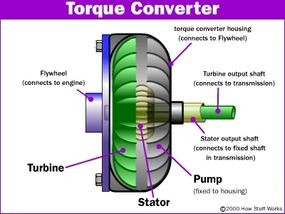The Automatic Torque Converter is a crucial component in vehicles with automatic transmissions, acting as a fluid coupling that allows the engine to spin independently of the transmission at a standstill, while also transmitting power efficiently when moving. Contained within a robust housing, the torque converter houses four key elements that work in harmony to achieve this seamless power transfer: the impeller, turbine, stator, and transmission fluid.
The torque converter’s housing is directly bolted to the engine’s flywheel. This connection means the entire unit rotates at the same speed as the engine crankshaft. Attached to this housing are the fins of the impeller, also known as the pump, ensuring they spin in unison with the engine. The internal arrangement of these parts is illustrated in the cutaway diagram below, showing their interconnectedness within the torque converter and their relationship to both the transmission and engine.
The Impeller: A Centrifugal Pump
At the heart of the automatic torque converter is the impeller, which functions as a centrifugal pump. As the engine turns the impeller, the fluid within is forced outwards due to centrifugal force. This is analogous to the spin cycle in a washing machine, where water is propelled to the outer edges of the drum. As the fluid moves outwards, it creates a vacuum at the center of the impeller, drawing in more fluid to maintain a continuous flow.
Turbine and Power Transmission
The fluid expelled by the impeller then enters the blades of the turbine. The turbine is mechanically linked to the transmission input shaft. As the high-velocity fluid strikes the curved blades of the turbine, it imparts rotational force, causing the turbine, and consequently the transmission, to spin. This rotational motion is the mechanism by which power is transferred from the engine, through the torque converter, and into the transmission. The curved design of the turbine blades is crucial; as fluid enters from the outside and must exit towards the center, this change in direction is what generates the force necessary to rotate the turbine.
This principle is rooted in physics: changing the direction of a moving object requires force. In this case, the fluid exerts a force on the turbine blades to change its direction, and in reaction, the turbine experiences an equal and opposite force, causing it to rotate. This rotation is then passed onto the transmission, ultimately driving the wheels of the vehicle.
The Stator: Enhancing Torque and Efficiency
After exiting the turbine at its center, the fluid is now moving in a direction opposite to the rotation of the impeller and engine. If this fluid were to directly impinge upon the impeller, it would oppose the impeller’s rotation, effectively working against the engine and reducing efficiency. This is where the stator comes into play.
The stator is positioned between the turbine and impeller. Its crucial function is to redirect the fluid flow returning from the turbine. By changing the fluid’s direction before it re-enters the impeller, the stator ensures that the fluid assists, rather than hinders, the impeller’s rotation. This redirection effectively multiplies the torque, especially at lower engine speeds, providing increased power to the wheels when needed, such as during acceleration. The stator is a key innovation in automatic torque converters, significantly enhancing their efficiency and performance compared to simple fluid couplings.
